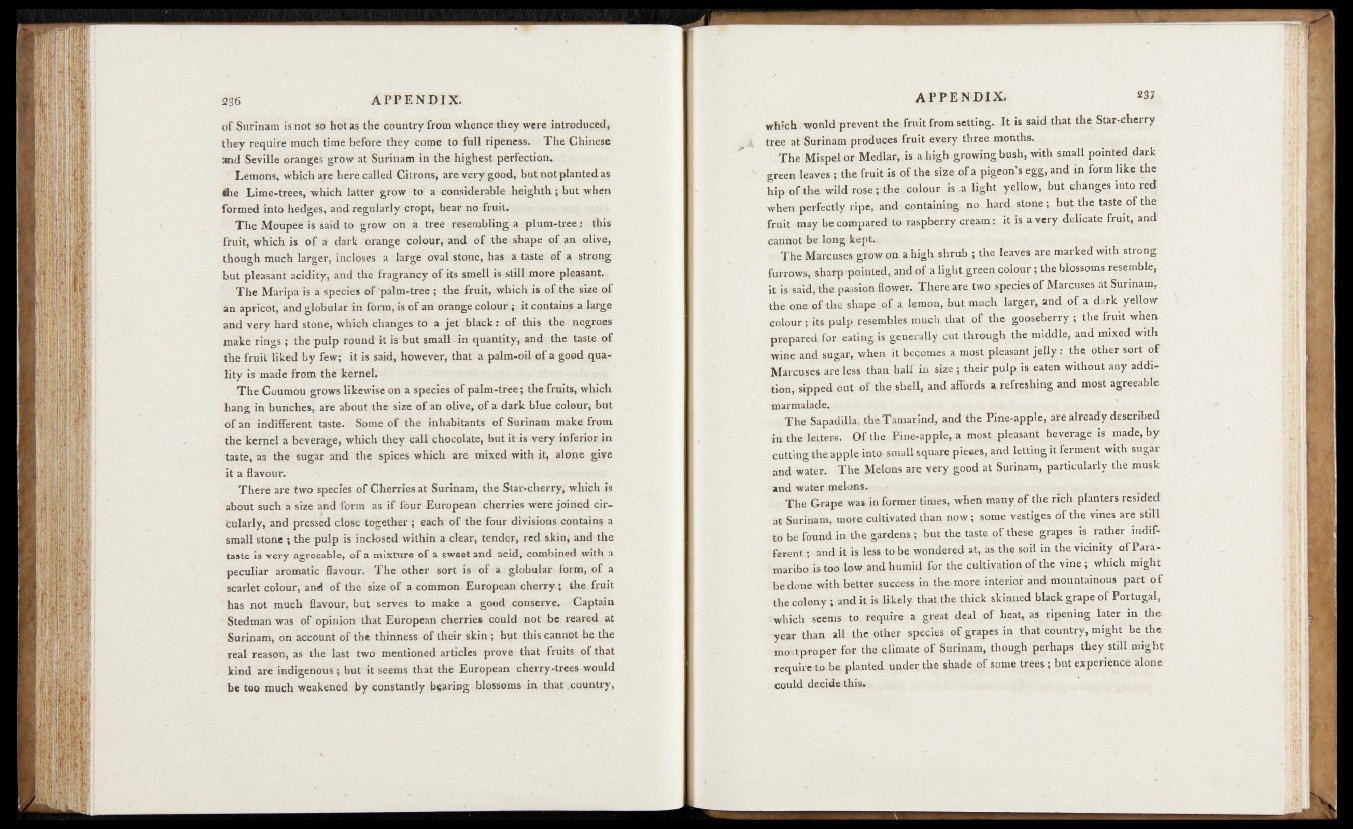
of Surinam is not so hot as the country from whence they were introduced,
they require much time before they come to full ripeness. The Chinese
and Seville oranges grow at Surinam in the highest perfection.
jU Lemons, which are here called Citrons, are very good, but hot planted as
tfce Lime-trees, which latter grow to a considerable heighth ; but when
formed into hedges, arid regularly cropt, bear no fruit.
The Moupee is said to grow on a tree resembling a plum-tree: this
ffuit, which is o f * dark orange colour, and o f the shape of an olive,
though much larger, incloses a- large oval stone, has a taste of a strong
but pleasant acidity, and the fragrahcy of its smell is still more pleasant.
The Maripa is a species of palm-tree ; the fruit, which is of the size ,qf
an apricot, and globular in form, is of an orange colour ; it containsi a large
^nrl very hard stone, which changes to a jet black: of this the xiegro.es
make rings:; the pulp round it is but small-in quantity, and the taste of
the fruit liked by few; it is said, however, that a palm-oil o f a good quality
is made from the kernel.
The Coumou grows likewise on a species of palm-tree; the fruits, which
hang in bunches, are about the size o f an olive, of a dark blue colour* but
of an indifferent taste. Some, o f the- inhabitants of Surinam make, from,
the kernel a beverage, which they call chocolate, but it is very inferior in
taste, a3 the sugar and the spices which are mixed with it* alone give
it a flavour.'
There are two species of Cherries at Surinam, the Star-cherry; which is
about such a size and form as if four European cherries were joined circularly,
and pressed close together ; each Of the four divisions contains a
small stone ; the pulp is inclosed within a clear, tender, red skin; and the
taste is very agreeable, of a mixture of a sweet and acid, combined with a
peculiar aromatic flavour. The other sort is of a globular form, of a
scarlet colour, and of the size of a common European cherry,; the fruit
has not much flavour, but serves to make a good conserve. Captain
Stedman was of opinion that European cherries could not be, reared j at
Surinam, on account of the thinness of their skin ; but this cannot he the
real reason, as the last two mentioned articles prove that fruits of that
kind are indigenous; but it seems that the European cherry-trees would
be too much weakened by constantly bearing blossoms in that .country,
which would prevent the fruit from setting. It is said that the Star-dherry
tree at Surinam produces fruit every three months.
The Mispel or Medlar,, is a,high growing bush, with small pointed dark
green leaves ; the fruit.is of the size of a pigeon’s egg, and m form like, the
hip of the wild rose.; the* colour, is ,a light, yellow, but changes into red
when perfectly ripe, and containing no hard S;tone; but the taste of the
fruit may be comparedto. raspberry cream : it. is a, very delicate fruit, and
cannot r be longikept^ . ,
The Marcuses grow on a high shrub ; the leaves are marked with strong,
furrows; sharp-pointed, and of ji light green colour;, the blossoms resemble;
it is said, the passion flower. There are two species qf Marcuses at Surinam,
the one of the shape of a lemon, but much. larger, and of a .dark yellow
colour ; its pulp resembles much that of the gooseberry ; the fruit when,
prepared for eating is generally cut through the middle, and mixed with
wine and sugar, when it becomes, a most pleasant j e lly : the other sort of
Marcuses are less than half in size ; their pulp is eaten without any addition,
sipped out o f :the shell, and affords a, refreshing and most agreeable
marmalade. . - .
The Sapadilla, the Tamarind, and the Pine-apple, are already described
in the letter«. Of the Pine-apple, a most pleasant beverage is made, by
cutting the apple into.sm?d.?ql«ir« I»««»*and ^ttirig it ferment with sugar
and water. The Melons are very good, at Surinam, particularly the musk
and water melons. , - .
The Grape was in former times, when many of the rich planters resided
at Surinam, more cultivated than now; some vestiges of the vines are still
to be found in the gardens ; but the t^stepf these grapes is rather indifferent;
and it is less to be wondered at, as thq soil in the vicinity of Paramaribo
is too low and humid for the cultivation of the vine ; whiqh might
be done with better success in the.more interior and. mountainous part o f
the colony ; and it is likely that the thick skinned black grape of Portugal,
which seems, to. require a great deal of heat,, as ripening later in the
year than all the qther species of grapes in t%fr cquntry, might be the
most proper for. the climate of £urin$W, though perhaps they still might-
require to be planted under the shade of some trees ; but experience afonc
could decide this.